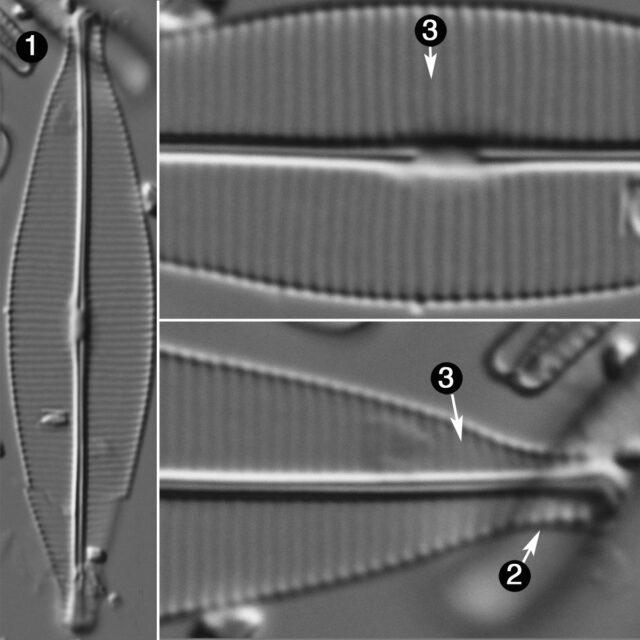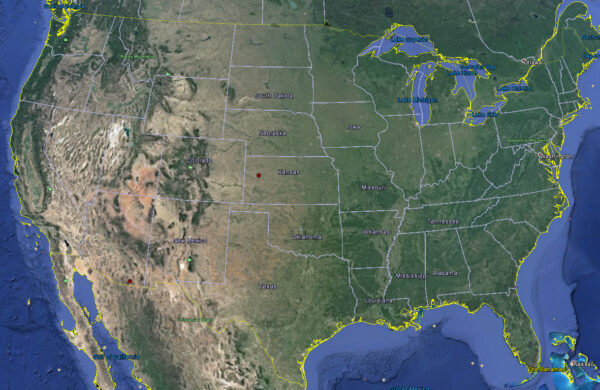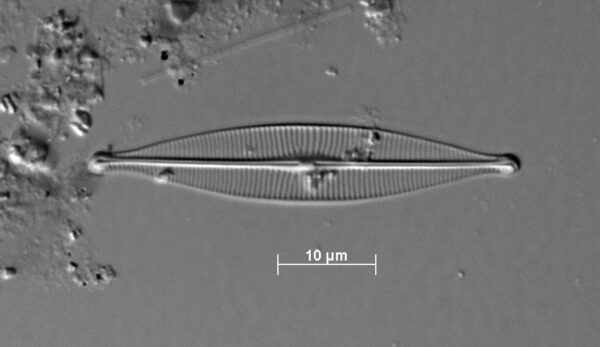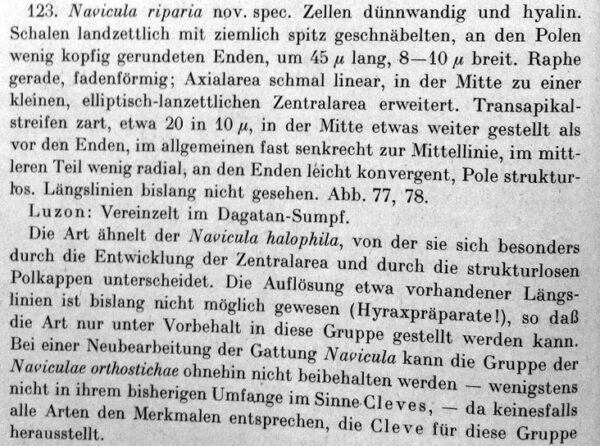Craticula riparia
-
Category
-
Length Range38-48 µm
-
Width Range8.7-10.7 µm
-
Striae in 10 µm17-20 at valve center, 16-20 at the ends
-
ContributorDavid R.L. Burge, Ian Bishop - May 2015
-
ReviewerPat Kociolek, Sarah Spaulding - Mar 2016
Identification
Description
Valves are slender and lanceolate, with rostrate to subcapitate apices. The valve face is mostly flat, however in most specimens, the apices tend to become out of focus, indicating a slightly convex valve face. Striae are parallel at the valve center, becoming convergent toward the apices. Striae near the central area may be slightly bent. Stria density isimilar but may be lower near the apices. Areolae are fine and not distinguishable in LM. The axial area is narrow along the raphe becoming slightly elliptic about the proximal raphe ends. The raphe is filiform, with slightly inflated proximal ends. The distal raphe ends are deflected unilaterally. Heribaudii valves were observed.
The iconotype of Hustedt (1942, and illustrated below) indicates a wide and distinctive central area. The drawing, however, appears to exaggerate the nature of the central area, as compared to the lectotype specimen (also shown below). We believe the specimens shown here conform to the lectotype.
Autecology
Records of C. riparia were confirmed in a number of sites based on archives at the Academy of Natural Sciences of Drexel University. These include specimens from state and federal monitoring projects (Badger Creek, Emmons County, ND (EPA NRSA), Apple Creek, Burleigh County, ND (EPA NRSA), an unnamed stream in central Wisconsin (EPA NRSA FW08RWI9044), Smoky Hill River, Elkader, KS (USGS NAWQA), Chopawamsic Creek, VA (Virginia DEQ) and in Moshannon Creek, PA.
In Europe, C. riparia has been reported from moderately acidic, high electrolyte streams (Lange-Bertalot 2001).
-
Size Range, µm3
-
Motility
-
Attachment
-
Habitat
-
Colony
-
Waterbody
- Learn more about this
Original Description
Navicula riparia nov. spec. Zellen dünnwandig und hyalin. Schalen landzettlich mit ziemlich spitz geschnäbelten, an den Polen wenig kopfig gerundeten Enden, um 45 µ lang, 8-10 µ breit. Raphe gerade, fadenförmig; Axialarea schmal linear, in der Mitte zu einer kleinen, elliptisch-lanzettlichen Zentralarea erweitert. Transapikal-streifen zart, etwa 20 in 10 µ, in der Mitte etwas weiter gestellt als vor den Enden, im allgemeinen fast senkrecht zur Mittellinie, im mittleren Teil wenig radial, an den Enden leicht konvergent, Pole strukturlos. Längslinien bislang nicht gesehen. Abb. 77, 78. Luzon: Vereinheit im Dagatan-Sumpf. Die Art ähnelt der Navicula halophila, von der sie sich besonders durch die Entwicklung der Zentralarea und durch die strukturlosen Polkappen unterscheidet. Die Auflösung etwa vorhandener Längslinien ist bislang nicht möglich gewesen (Hyraxpräparate!), so daß die Art nur unter Vorbehalt in diese Gruppe gestellt werden kann. Bei einer Neubearbeitung der Gattung Navicula kann die Gruppe der Naviculae orthostichae ohnehin nich beibehalten werden - wenigstens nich in ihrem bisherigen Umfange im Sinne-Cleves, - da keinesfalls alle Arten den Merkmalen entsprechen, die Cleve für diese Gruppe herausstellt.
-
BasionymNavicula riparia
-
AuthorHust. 1942
-
Length Range45 µm
-
Width8-10 µm
-
Striae in 10µm20
Citations & Links
Citations
Cite This Page
Burge, D., Bishop, I. (2015). Craticula riparia. In Diatoms of North America. Retrieved April 19, 2024, from https://diatoms.org/species/craticula_riparia
Responses
The 15 response plots show an environmental variable (x axis) against the relative abundance (y axis) of Craticula riparia from all the stream reaches where it was present. Note that the relative abundance scale is the same on each plot. Explanation of each environmental variable and units are as follows:
ELEVATION = stream reach elevation (meters)
STRAHLER = distribution plot of the Strahler Stream Order
SLOPE = stream reach gradient (degrees)
W1_HALL = an index that is a measure of streamside (riparian) human activity that ranges from 0 - 10, with a value of 0 indicating of minimal disturbance to a value of 10 indicating severe disturbance.
PHSTVL = pH measured in a sealed syringe sample (pH units)
log_COND = log concentration of specific conductivity (µS/cm)
log_PTL = log concentration of total phosphorus (µg/L)
log_NO3 = log concentration of nitrate (µeq/L)
log_DOC = log concentration of dissolved organic carbon (mg/L)
log_SIO2 = log concentration of silicon (mg/L)
log_NA = log concentration of sodium (µeq/L)
log_HCO3 = log concentration of the bicarbonate ion (µeq/L)
EMBED = percent of the stream substrate that is embedded by sand and fine sediment
log_TURBIDITY = log of turbidity, a measure of cloudiness of water, in nephelometric turbidity units (NTU).
DISTOT = an index of total human disturbance in the watershed that ranges from 1 - 100, with a value of 0 indicating of minimal disturbance to a value of 100 indicating severe disturbance.

Craticula riparia
- Valves slender, lanceolate
- Apices rostrate to subcapitate
- Striae parallel to convergent
Valves are slender and lanceolate, with rostrate to subcapitate apices. Striae are parallel in the center of valve becoming convergent at the ends.
 Diatoms of North America
Diatoms of North America









